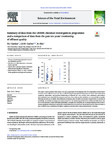Summary of data from the UKWIR chemical investigations programme and a comparison of data from the past ten years' monitoring of effluent quality
| dc.contributor.author | Gardner, MJ | |
| dc.contributor.author | Comber, Sean | |
| dc.contributor.author | Ellor, B | |
| dc.date.accessioned | 2022-04-22T12:01:24Z | |
| dc.date.issued | 2022-08-01 | |
| dc.identifier.issn | 0048-9697 | |
| dc.identifier.issn | 1879-1026 | |
| dc.identifier.other | 155041 | |
| dc.identifier.uri | http://hdl.handle.net/10026.1/19046 | |
| dc.description.abstract |
This paper reports summary data from a ten-year programme of investigation into the composition of wastewater treatment works' effluents in the UK. The so-called Chemical Investigations Programme focused on determinands of regulatory importance and involved monitoring of effluents for over seventy trace substances and sanitary determinands at more than 600 UK treatment works sites. The results provide a definitive overview of effluent quality. Although raw data are available, this publication of summary data provides a convenient résumé of the current state of knowledge. An analysis of changes in concentrations over the monitoring period between 2010 and 2020 shows that for several substances (nickel, diethylhexylphthalate, nonylphenol, tributyltin, the brominated diphenyl ethers and triclosan) significant reductions in wastewater concentration have occurred over the period of interest, these are likely to have resulted from a combination of tighter regulatory controls and/or improved wastewater treatment. | |
| dc.format.extent | 155041-155041 | |
| dc.format.medium | Print-Electronic | |
| dc.language | en | |
| dc.language.iso | eng | |
| dc.publisher | Elsevier | |
| dc.subject | Chemical | |
| dc.subject | Effluent | |
| dc.subject | Priority substance | |
| dc.subject | Regulation | |
| dc.subject | Wastewater | |
| dc.subject | Environmental Monitoring | |
| dc.subject | Waste Disposal, Fluid | |
| dc.subject | Wastewater | |
| dc.subject | Water Pollutants, Chemical | |
| dc.subject | Water Purification | |
| dc.title | Summary of data from the UKWIR chemical investigations programme and a comparison of data from the past ten years' monitoring of effluent quality | |
| dc.type | journal-article | |
| dc.type | Journal Article | |
| plymouth.author-url | https://www.ncbi.nlm.nih.gov/pubmed/35390381 | |
| plymouth.volume | 832 | |
| plymouth.publication-status | Published | |
| plymouth.journal | Science of the Total Environment | |
| dc.identifier.doi | 10.1016/j.scitotenv.2022.155041 | |
| plymouth.organisational-group | /Plymouth | |
| plymouth.organisational-group | /Plymouth/Faculty of Science and Engineering | |
| plymouth.organisational-group | /Plymouth/Faculty of Science and Engineering/School of Geography, Earth and Environmental Sciences | |
| plymouth.organisational-group | /Plymouth/REF 2021 Researchers by UoA | |
| plymouth.organisational-group | /Plymouth/REF 2021 Researchers by UoA/UoA06 Agriculture, Veterinary and Food Science | |
| plymouth.organisational-group | /Plymouth/Research Groups | |
| plymouth.organisational-group | /Plymouth/Research Groups/BEACh | |
| plymouth.organisational-group | /Plymouth/Research Groups/Marine Institute | |
| plymouth.organisational-group | /Plymouth/Users by role | |
| plymouth.organisational-group | /Plymouth/Users by role/Academics | |
| dc.publisher.place | Netherlands | |
| dcterms.dateAccepted | 2022-03-31 | |
| dc.rights.embargodate | 2022-4-23 | |
| dc.identifier.eissn | 1879-1026 | |
| dc.rights.embargoperiod | Not known | |
| rioxxterms.versionofrecord | 10.1016/j.scitotenv.2022.155041 | |
| rioxxterms.licenseref.uri | http://www.rioxx.net/licenses/all-rights-reserved | |
| rioxxterms.licenseref.startdate | 2022-04-04 | |
| rioxxterms.type | Journal Article/Review |


